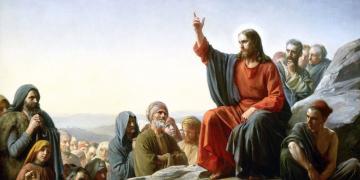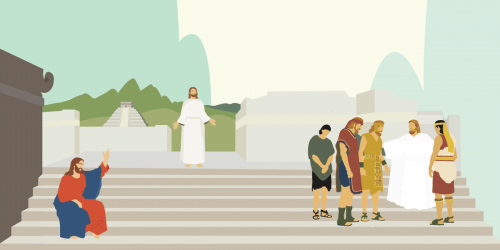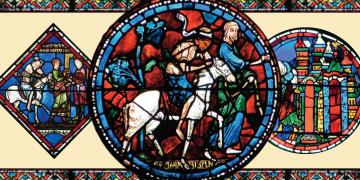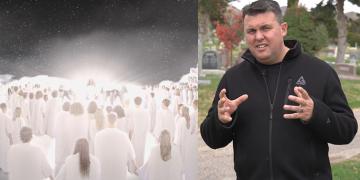You are here
Book of Mormon Central is in the process of migrating to our new Scripture Central website.
We ask for your patience during this transition. Over the coming weeks, all pages of bookofmormoncentral.org will be redirected to their corresponding page on scripturecentral.org, resulting in minimal disruption.
Recorded in the gospels of Matthew and Luke, the Sermon on the Mount has made a big impact on both Christian faith as well as broader Western culture. Even non-Christians are familiar with, and often use, language and concepts from Jesus’ sermon. Phrases such as “the salt of the earth,” “the light of the world,” “a city on a hill,” “love your enemies,” and other expressions have become part of everyday speech, and all come from the opening chapter of the Sermon on the Mount recorded in Matthew 5.
Latter-day Saints are especially drawn to the Sermon on the Mount since the Book of Mormon records the resurrected Jesus delivering a comparable, nearly verbatim version of the same sermon in the New World (3 Nephi 12–14). Latter-day Saints can especially appreciate this version of the sermon because Jesus delivered it at the temple and included many subtle temple themes and imagery.1
Read: How the Sermon on the Mount in 3 Nephi teaches us about the temple
What it means to be perfect
One of the things that Jesus commands in the Sermon on the Mount is to be perfect. Perfection is a high bar to reach and can often cause followers of Christ to feel inadequate or unworthy. It’s easy to feel the pressure to always do what’s right and to never make mistakes. Jesus specifically said:
Be ye therefore perfect, even as your Father which is in heaven is perfect.
While many followers of Christ may feel overwhelmed and discouraged by such a commandment, maybe we don’t need to be so hard on ourselves. God knew that, except for the Savior Himself, mankind would universally give in to sin and temptation. That is why God sent Christ to atone for our sins. Helping mankind learn and grow from their mistakes is a fundamental part of God’s plan for His children.
The meaning behind the Greek
The word perfect in Matthew 5:48 is telieos, which can mean “finished” or “completed.” It does not necessarily mean “without mistakes or flaws.” The Hebrew equivalent of this word also has a lot more to do with completion than with flawlessness. When we belittle ourselves for making mistakes, we may be reading into the scripture more than Jesus or the author of Matthew ever intended.
The emphasis on covenants
In addition, the Book of Mormon’s version of this sermon helps us understand that Christ’s commandment to be perfect may be more about covenants than about our current sinlessness. In the Book of Mormon, Jesus precedes the commandment to be perfect with a discussion about the old laws and covenants. Elsewhere in the Old Testament, where perfection is brought up, it is in the context of one’s devotion to God and His covenants. It’s possible that when Jesus commands us to be perfect, He is commanding us to keep our covenants to God as best we can.
Jesus was only perfect after his resurrection
In the Book of Mormon, Jesus uniquely commands followers to be perfect “as I, or your Father” is perfect. In the New Testament, Jesus only commands His followers to be perfect like the Father. This is an important distinction because it shows that even Jesus Christ, who lived a sinless life, did not consider Himself “perfect” until His mission was completed. Likewise, we can understand that while we make mistakes in this life, as long as we are always striving to be loyal to God and our covenants, we will one day be perfect like Jesus Christ.

Doctrinal Mastery 3 Nephi 12:48 Infographic by Book of Mormon Central
Read more about the Book of Mormon’s use of “perfect” in this KnoWhy
The importance of studying the Sermon on the Mount with the Sermon at the Temple
As scholar John W. Welch has explored at length, reading the Sermon on the Mount recorded in the New Testament with a Restoration perspective draws out significant insights from Jesus’ teachings. “This contextual information, supplied solely by the Book of Mormon, offers some important keys to the Sermon on the Mount itself—to its internal coherence, purpose, and unity,” writes Welch. “These keys open new ideas about these words of Jesus, inviting study and reflection for years to come. Just as the Sermon on the Mount has provided fertile ground for spiritual and scholarly research for hundreds of years in Bible studies, the same will undoubtedly be the case with the Sermon at the Temple in Book of Mormon research.”2
Latter-day Saints thus greatly benefit from reading the Sermon on the Mount in Matthew and the Sermon at the Temple in 3 Nephi together. While the versions of this sermon recorded in Matthew and 3 Nephi can rightly be read on their own, and provide unique details that can be appreciated independently, weaving them together offers members of The Church of Jesus Christ of Latter-day Saints an approach to this seminal sermon perfectly suited to their spiritual and intellectual needs.
Related Articles
- 1. John W. Welch, Illuminating the Sermon at the Temple and the Sermon on the Mount (Provo, UT: FARMS, 1999); The Sermon on the Mount in the Light of the Temple (Farnham: Ashgate, 2009).
- 2. Welch, Illuminating the Sermon at the Temple and the Sermon on the Mount, 17.
Subscribe
Get the latest updates on Book of Mormon topics and research for free










